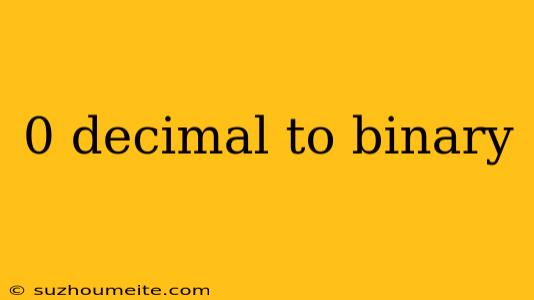Decimal to Binary Conversion: A Step-by-Step Guide
In the world of computer science and programming, understanding how to convert decimal numbers to binary is a fundamental concept. Binary is the language of computers, and being able to convert decimal numbers to binary is crucial for programming and coding. In this article, we will explore the process of converting decimal numbers to binary, including examples and step-by-step instructions.
What is Decimal?
Decimal is a base-10 number system that uses 10 digits from 0 to 9 to represent numbers. It is the most common number system used in everyday life, and it is the system that most people are familiar with.
What is Binary?
Binary, on the other hand, is a base-2 number system that uses only two digits: 0 and 1. It is the language of computers and is used to represent information in computer systems.
How to Convert Decimal to Binary
Converting decimal to binary is a simple process that involves dividing the decimal number by 2 and noting the remainder. Here are the steps:
Step 1: Divide the Decimal Number by 2
Start by dividing the decimal number by 2.
Step 2: Note the Remainder
Note the remainder of the division. If the remainder is 0, write down 0. If the remainder is 1, write down 1.
Step 3: Repeat Steps 1 and 2
Repeat steps 1 and 2 until the quotient is 0.
Step 4: Read the Remainders in Reverse Order
Read the remainders in reverse order to get the binary equivalent of the decimal number.
Examples
Let's convert the decimal number 12 to binary using the steps above:
Convert 12 to Binary
- Divide 12 by 2: 12 ÷ 2 = 6 with a remainder of 0
- Divide 6 by 2: 6 ÷ 2 = 3 with a remainder of 0
- Divide 3 by 2: 3 ÷ 2 = 1 with a remainder of 1
- Divide 1 by 2: 1 ÷ 2 = 0 with a remainder of 1
Read the remainders in reverse order: 1100
Therefore, the binary equivalent of the decimal number 12 is 1100.
Another example is converting the decimal number 25 to binary:
Convert 25 to Binary
- Divide 25 by 2: 25 ÷ 2 = 12 with a remainder of 1
- Divide 12 by 2: 12 ÷ 2 = 6 with a remainder of 0
- Divide 6 by 2: 6 ÷ 2 = 3 with a remainder of 0
- Divide 3 by 2: 3 ÷ 2 = 1 with a remainder of 1
- Divide 1 by 2: 1 ÷ 2 = 0 with a remainder of 1
Read the remainders in reverse order: 11001
Therefore, the binary equivalent of the decimal number 25 is 11001.
Conclusion
In conclusion, converting decimal numbers to binary is a simple process that involves dividing the decimal number by 2 and noting the remainder. By following the steps outlined in this article, you can easily convert decimal numbers to binary. Understanding how to convert decimal to binary is an essential skill for anyone interested in computer science and programming.
